

Documentary on Holistic Management. Brighteon. Rare Plant Profiles. The plant profiles presented on this website are proposed or listed as threatened or endangered (TEP) by the U.S.

Fish and Wildlife Service, under the Endangered Species Act (ESA), or if not listed, are ranked as Critically Imperiled by NatureServe. Each of these plants is known to currently exist in at least one location on national forests or national grasslands. About the Rare Plant Profiles… Select Rare Plant Profiles Select a specific rare plant profile on our All Species list or on lists of rare plant profiles "By State" or "By National Forest/Grassland".
Select Rare Plant Profiles by Forest Service Region You may select a Forest Service Region below to display lists of rare plant profiles for that region of the United States. 100 y/o Study □ "Carbonic Acid*" Does THIS To FOOD!!! (8) Why Demand For Seaweed Is About To Boom. (2) 'Secret Weapon' for Grand Solar Minimum / Infrastructure Failing. How to Get FREE Blueberry Plants from Store Bought Blueberries! 12 Perfect Vegetables To Grow in a Shady Garden Space. Gardening with hydrogen peroxide - Mixing Charts. 11 Mega Reasons Why Hydrogen Peroxide For Plants Is A Must. Is your garden looking less than perfect?
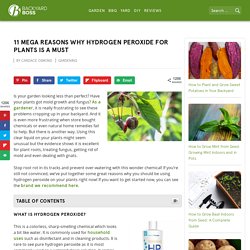
Have your plants got mold growth and fungus? As a gardener, it is really frustrating to see these problems cropping up in your backyard. And it is even more frustrating when store bought chemicals or even natural home remedies fail to help. But there is another way. Using this clear liquid on your plants might seem unusual but the evidence shows it is excellent for plant roots, treating fungus, getting rid of mold and even dealing with gnats. GARY’S TIPS FOR GROWING AVOCADO TREES. How to Grow 21 Amazing Trees from Seed (Full Presentation) How To Grow Tomato Plants From Cuttings In 1 Week. How to Grow Potatoes in a 5 Gallon Bucket (Part 1 of 2) 12 Fastest Growing Vegetables You Can Grow NOW! - Survival Garden -Self Sufficient Sunday #2. 8 Easy Steps to Start Your Best Vegetable Garden! How to Grow Microgreens from Start to Finish (COMPLETE GUIDE)
Tricyrtis - Perennial Toad Lilies for the Woodland Garden. Introduction to Tricyrtis Tricyrtis (toad lilies) is a shade-loving perennial in the lily family whose small but beautiful and intricately designed orchid-like flowers stop people in their tracks.
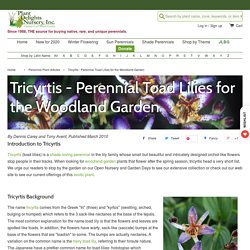
When looking for woodland garden plants that flower after the spring season, tricyrtis head a very short list. We urge our readers to stop by the garden on our Open Nursery and Garden Days to see our extensive collection or check out our web site to see our current offerings of this exotic plant. Tricyrtis Background The name tricyrtis comes from the Greek "tri" (three) and "kyrtos" (swelling, arched, bulging or humped) which refers to the 3 sack-like nectaries at the base of the tepals. A more infamous and blatantly false story for the origin of the name toad lily is widely circulated and appears in many prominent Tricyrtis publications. The genus Tricyrtis is east Asian in origin.
History of Tricyrtis in the Garden Prior to 1784, the history of tricyrtis use in Asia is clouded. Conclusion. Food Supply Reality – Shepherds Heart. This article is dedicated to my faithful patrons who make my writings possible.
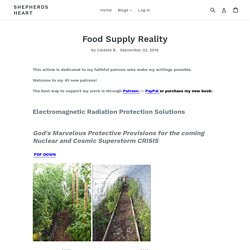
Welcome to my 45 new patrons! The best way to support my work is through Patreon or PayPal or purchase my new book: Electromagnetic Radiation Protection Solutions God's Marvelous Protective Provisions for the coming Nuclear and Cosmic Superstorm CRISIS 2017, this is only a portion of the harvest. Sativum. Sativa, sativus, and sativum are Latin botanical adjectives meaning cultivated, used to designate certain seed-grown domestic crops.[1] Sativa (ending in -a) is the feminine form of the adjective, but masculine (-us) and neuter (-um) endings are also used to agree with the gender of the nouns they modify.

For example, the masculine Crocus sativus and neuter Pisum sativum. Examples of crops incorporating this word and its variations into their Latin name include: Vanilla Planifolia Orchid Plant. Vanilla beans grow from a particular species of orchid called Vanilla planifolia.

In fact, vanilla beans are the only edible fruit produced from an orchid plant. Fresh vanilla bean and its pure extracts can be quite expensive. Growing them at home can be more than a novelty, but a cost-saving challenge for the ambitious gardener. Which Fertilizer Element Encourages Flowering Growth in Plants? Flower growth on a plant is an essential part of the plant's reproduction.
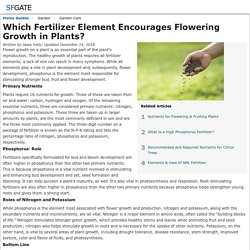
The healthy growth of plants requires all fertilizer elements; a lack of one can result in many symptoms. While all elements play a role in plant development and, subsequently, flower development, phosphorus is the element most responsible for stimulating stronger bud, fruit and flower development. Primary Nutrients. Shrubs for Partial Shade and Full Shade Areas.
Ginseng 101 - Where to Find - How to Harvest. 100+ Garden Projects using Sticks & Twigs. Tons of Vegetables Planted in Tiny Garden - Food Forest. Changing varieties in old Pear Trees. Growing Citrus from Cuttings – Rooting and Grafting Citrus in One Step. Basil, How To Grow More Than You Can Eat. From Tree to Table: gathering and processing acorns.
The Wild Plant Cafe- GOURMET WEEDS. How To Make A Flow Through Worm Composter. How To Heat A Greenhouse For FREE. Vines That Thrive in Partial Sun. One consideration when choosing a vine for part sun is just how much sun the plant will get.
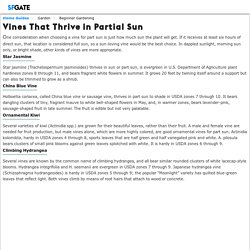
If it receives at least six hours of direct sun, that location is considered full sun, so a sun-loving vine would be the best choice. In dappled sunlight, morning sun only, or bright shade, other kinds of vines are more appropriate. Star Jasmine Star jasmine (Trachelospermum jasminoides) thrives in sun or part sun, is evergreen in U.S. Department of Agriculture plant hardiness zones 8 through 11, and bears fragrant white flowers in summer. China Blue Vine Holboellia coriacea, called China blue vine or sausage vine, thrives in part sun to shade in USDA zones 7 through 10. Ornamental Kiwi Several varieties of kiwi (Actinidia spp.) are grown for their beautiful leaves, rather than their fruit. Climbing Hydrangea Several vines are known by the common name of climbing hydrangea, and all bear similar rounded clusters of white lacecap-style blooms.
About the Author. Baker Creek Heirloom Seeds. Hybrid Varieties and Saving Seed. Hybrid Seeds vs. GMOs. Hybrid Seeds.

Genetically-modified (GMO) seeds. Heirloom seeds. The labels often confuse people. Not a single day passes without some well-meaning reader leaving a comment like this one: “GMOs are perfectly safe. Wild Edible Plants. The Tree Guide at arborday.org. The Foraged Foodie: Foraging: Identifying Juneberries (Serviceberries & Shadbush) 135Save Identification difficulty: Beginner This year, the sheer abundance of berries made them impossible to ignore.

For the past 3+ weeks, I have made berry pancakes, berry drinks, various breads and muffins, added berries to frozen banana "ice cream" and even made a sweet and spicy sauce with mulberries and chipotle for chicken. (I'll get around to a mulberry post soon, I promise!) Identification The Juneberry is a variety of Amelanchier which happens to ripen in June. The fruit is purple-black when ripe, red when unripe, and has a crown. I would feel pretty confident on the safety of ID-ing Juneberries, since Steve Brill says that no North American fruit with a crown is poisonous.Good to know! The bark of tree or shrub (the plant can appear as either) is silvery grey or blackish, and it apparently frequently features vertical striations, but that wasn't the case with my trees. You Bet Your Garden - Black Walnuts? No Worries! Black Walnuts? No Worries! Some Plants Thrive Near Those 'Terrible' Trees Q. Mike: HELP! Alternative Edible Leaves.
Alternative Edible Leaves Most of the leaf crops we grow for food are annual plants - with all the work and problems associated with the growing of annuals such as digging the soil, preparing seed beds, sowing seed, weeding, more weeding and yet more weeding. This section is going to look at a few of the many perennial leaf crops that can be grown in the garden with a fraction of the work and often with higher total yields. Whilst many perennial food crops can be slow to begin yielding, growing perennial plants for their leaves will usually give you at least a small crop in the first year and this will then increase in the following years. 2014 BONAP North American Plant Atlas. BONAP maintains relatively complete phytogeographic and related botanical databases for all free-living vascular plants found in North America (north of Mexico).
For over four decades, we have worked collaboratively with many federal and state government agencies, private groups and individuals across the continent to produce and edit our databases. Therefore, we feel that our county-level database has matured sufficiently to allow us to post all of our integrated county-level maps for the North American ferns and allies, conifers and flowering plants. BONAP plans to provide periodic updates of these maps at regular intervals. 21 DIY Greenhouses with Great Tutorials - A Piece of Rainbow.
50 Ideas Mosaic Garden Path Tiles. How to Tell Watermelon is Ripe - 4 Tips for Picking Good Watermelon.
Living Fences: How-To, Advantages, and Tips - Modern Homesteading - MOTHER EARTH NEWS. Living fences offer a more sustainable, longer-lasting fencing option for your homestead. Fences on your farm or homestead define property boundaries and separate production zones (garden, pasture, orchard). They provide privacy and security from animal (and perhaps human) intruders. They confine livestock and protect them from predators. They guard crop areas from wild raiders (such as deer) as well as animal allies (such as sheep and goats).
Your first choice for such a multifunctional homestead necessity may be manufactured fencing: woven or electric wire, welded livestock panels, boards on pressure-treated posts, or even virgin or recycled plastic. A living fence is a permanent hedge tight enough and tough enough to serve almost any of the functions of a manufactured fence, but it offers agricultural and biological services a manufactured fence cannot. Depending on the plant or tree species you choose, living fences can provide food and medicine or fodder for your livestock. How to build My 50 Dollar Greenhouse. First off – you really can build this thing very cheaply, but to do so you have to recycle, freecycle, and scrounge.
Monsanto purchases five seed companies. Monsanto’s subsidiary American Seeds Inc. (ASI) just increased its family of regional seed companies by five. ASI announced plans to purchase on July 1 Kruger Seed Company, Dike, IA; Diener Seeds, Reynolds, IN; Sieben Hybrids, Geneseo, IL; Trisler Seed Farms, Fairmount, IL; and Campbell Seed, Tipton, IN. Major Organic Seed Company Owned By Pro-GMO Group! Barbara H. Best Herbs for Teas (National Gardening Association) Once I began blending and testing herb teas to sell under my Garden Party label, I knew what I didn't want.
How to grow a fig tree from a cutting part 1. How To Make Effective Microorganisms - Step By Step. Last night, when deciding what to write about for today, I looked around my apartment, saw my probiotic fermenting away on the shelf, immediately took this photo, and proceeded to write this step by step process for making effective microorganisms. In gardening, there’s a lot of talk about chemistry – the fertilizer, NPK, carbon, etc.
All important stuff, but I like to spend just as much time on the biology – the microorganisms, insects, animals (and of course plants). It’s especially the microorganisms that really rule our world, our bodies (we contain 10 times as many microbes as we do human cells), and our gardens. Flowers that look like Animals,Insects and People. Perennial-farming-systems-organic-agriculture-edible-permaculture-eric-toensmeier-large-scale-farmland. Growing Garlic, Harvesting Garlic, Planting Garlic, Garlic Scapes. Garlic growing is easy in the home garden. Maintaining top quality requires care and attention. Wild Edible Plants. The Wild Plant Cafe- GOURMET WEEDS. Foraging for Wild Food: 6 Sustainable Techniques.
Foraging: 52 Wild Plants You Can Eat. Here are a few common North American goodies that are safe to eat if you find yourself stuck in the wild: Start Eating Purple. How to Grow the Best Green SuperFood that has more Protein than Beef Indoors. Which Fertilizer Element Encourages Flowering Growth in Plants? ATP Podcast #15: Edible Wild Plants - Garden.org. How to Make an Avocado Tree Bear Fruit. How To Grow Watercress. Testing Your Soil pH Without a Kit. Barn Greenhouse - DIY Projects. Effective Microorganisms. Green 3D Printer Prints Living Designs From Organic “Ink” Growing Figs in Containers.
Ideas for growing. How to Make $100,000 Farming 1/2 Acre You Don't Own. Wild Edible Greens, Foraging Your Own Wild Superfoods. DIY Strawberry Tower With Reservoir. THE MIRACLE OF GROWING FOOD SUSTAINABLY. Plants Profile for Cistus incanus incanus (hairy rockrose) WHO's New Q & A on Glyphosate Confirms Toxicity of Round Up. The Poison Garden website Guide to Common Plant Names. How To Grow Potatoes in Tire Towers. Monsanto Buys Up Heirloom Seed Suppliers. Healthy News and Information. How to Build a Tumbling Composter: 11 Steps.
Healthy Facts About Those Roly Poly Bugs In Your Yard. How to Grow Hydroponics Without Chemicals. Top 12 shade tolerant vegetables and herbs for a shady garden. How To Use Your Pee For The Planet. 6,000 lbs of food on 1/10th acre - Urban Farm - Urban Homestead - Growing Your Own Food.
Persimmon Provisions. Pumpkins and Winter Squash- Harvesting and Storage. Plant Identification. Guy Creates Trees That Grow 40 Different Fruits. Eat The Weeds by Green Deane, the most watched forager in the world. WILD FLOWER IDENTIFICATION GUIDE (ID GUIDE) Search by State. eBook. Self-Seeding Crops You’ll Never Need to Replant.